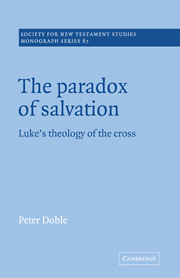Book contents
- Frontmatter
- Contents
- Preface
- List of abbreviations
- PART I Luke's theology of the cross: preliminary matters
- PART II Substantial matters: three distinctive elements at Luke 23.46, 47
- 2 Luke's use of δοξáζειν τòν Θεóν
- 3 Δíκαιος and ‘innocent’: Luke 23.47
- 4 Δίκαιος in Luke's Gospel
- 5 Δίκαιος as a christological descriptor: Acts
- 6 ‘Father, into thy hands …’
- PART III Echoes of Wisdom in Luke's theology of the cross
- Bibliography
- Index of biblical references
- Index of authors
6 - ‘Father, into thy hands …’
Published online by Cambridge University Press: 15 December 2009
- Frontmatter
- Contents
- Preface
- List of abbreviations
- PART I Luke's theology of the cross: preliminary matters
- PART II Substantial matters: three distinctive elements at Luke 23.46, 47
- 2 Luke's use of δοξáζειν τòν Θεóν
- 3 Δíκαιος and ‘innocent’: Luke 23.47
- 4 Δίκαιος in Luke's Gospel
- 5 Δίκαιος as a christological descriptor: Acts
- 6 ‘Father, into thy hands …’
- PART III Echoes of Wisdom in Luke's theology of the cross
- Bibliography
- Index of biblical references
- Index of authors
Summary
Jesus' last word
Luke's account of Jesus' last word confirms that he was working with a δίκαιος-model. In Luke's version Jesus' final word was, Πάτερ, εἰς χεĩράς σου παρατίθεμαι τò πνεῦμά μου (Luke 23.46), which is entirely consistent with what Wisdom had affirmed would be the lot of God's δίκαιοι (Wis. 3.1). Whatever seems to be their loss or suffering, they are in God's hands. Whether Luke rewrote Mark's cry of dereliction because he had already begun to think of Jesus as the δίκαιος, or whether the tradition of Jesus' death that he received already treasured Psalm 30.6(31.5) as Jesus' last word which then directed Luke's or his church's mind to WisdomL's model, is probably an insoluble problem. Significantly, in Luke, Jesus' last word schematically coheres with the centurion's recognition of Jesus as ὄντως … δίκαιος; both changes probably originate in the same underlying model, each confirming the other.
This argument recognises that for Luke there was at this point only one word of Jesus from the cross. Attempts to show that Luke's saying was a supplementary form to that found in Mark or Matthew tend to founder on two hard facts. First, the structure of Luke's sentence seems to preclude the possibility of there being more than one ‘final’ word: … καὶ φωνήσας φωνῇ μεγάλῃ ὁ' Ιησοῦς εἶπεν, Πάτερ … τοῦτο δὲ εἰπὼν ἐξέπνευσεν (Luke 23.46–7).
- Type
- Chapter
- Information
- The Paradox of SalvationLuke's Theology of the Cross, pp. 161 - 184Publisher: Cambridge University PressPrint publication year: 1996



